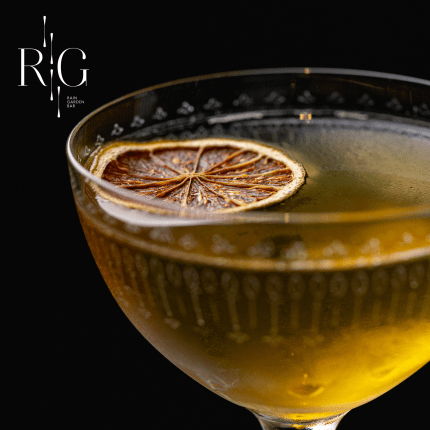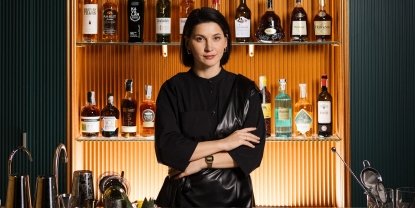A three-time vice-champion of the world (IBA World Cocktail Competition, International Cocktail Championship, Golden Cup International Cocktail Competition) and two-time champion of Ukraine, mixologist Maryna Pikush, devotes herself to her favourite work. In 2015, she discovered mixology for herself and has mastered it perfectly. When she was preparing for the world championships, she could not eat for two or three weeks - neither sweet nor salty - to feel the drink she was creating.
This is an online.ua conversation with mixologist Maryna Pikus about creative search, professional mission, the craziest cocktails and how to get to know the culture of tasting drinks.
The essence is inside the glass
A mixologist can be compared to a bartender, as a dietician can be compared to a nutritionist. A nutritionist is responsible for the health of the human body. A nutritionist only understands food, and he can break it down into molecules.
The mission of mixology lies in sensations. If a mixologist knows the "backbone" of a classic cocktail, he will create it from any ingredients that fit the category because he feels the drink. The mixologist creates the formula and adjusts the taste, density, aftertaste, and aromas.
A mixologist understands the essence of everything inside a glass. If you want to create elegant things, you must have a graceful heart.

Maryna Pikush
mixologist
The barman is responsible for the atmosphere, pouring according to the cards handed down to him. The mixologist is accountable for each cocktail's structure, dishes, and serving—ice, decorations, filling, density, and acidity.

Mixology is about balance
A bartender is an artist who mixes ingredients like paints. If you mix all the colors together, you will get a dirty color. And if you choose a palette? The same goes for mixing alcohol. There should be a balance: both in the nose, and in the larynx, and in the oral cavity.
The idea of a new cocktail in everyday life can inspire Marina. For example, she saw a combination of the aromas of rose and lychee — and is already preparing a drink because she is interested in what it will be.
Talent is about curiosity. If you memorise the formula, sooner or later you will run into a dead end, because the puzzles will not fit together. The proportions are correct, but the taste can be terrible. Therefore, it is important for me to feel how the volume of ice affects the cocktail, or the weather outside changes the aroma and aftertaste of the drink.

Maryna Pikush's path in mixology
2017 Marina won the International Bartender Association national competition. Afterwards, she visited Denmark to represent Ukraine at the IBA World Cocktail Competition. Representatives from 69 countries took part.
I prepared for the championship for two months, six hours a day. Every movement had to be ideally practised. Because the drop that fell on the table is a penalty point, points will also be deducted if you don't put in the time. We competed for four days, and I took the "silver." No one expected it because Ukraine went to these championships for 11 years in a row, and during that time, we took only one bronze medal.

Maryna Pikush
mixologist
In 2018, Maryna won silver among more than 40 participants at the Rookie Challenge as part of the International Cocktail Championship held in Stuttgart, Germany.

In the same year, Marina went to Taiwan to win. However, she paid for tickets, accommodation, an interpreter, and even a visa at her own expense.
The Golden Cup International Cocktail Competition is one of the largest championships in Asia. Asians are gods in mixology, they have other herbs, plants, receptors.
Marina took seven suitcases to Taiwan. They had glasses, ice buckets, shakers, strainers, measuring cups, an induction stove, pans, and even isomalt swans for decoration.
In November 2018, Marina won a silver medal at the 22nd Golden Cup International Cocktail Competition in Taiwan.

Mixologist Maryna Pikush is a three-time vice-champion of the world and a two-time champion of Ukraine. In the list of her victories:
First place in the national selection in 2017;
Silver medal in 2017;
First place in 2018;
Silver medal in 2018;
Silver medal in 2018.
"Insulin bomb" or the Art
I like dry sparkling wines. I can have a glass in the evening. The most important thing is, of course, the dose. And then the right combination of alcohols and sugars.
Marina once learned to create a cocktail formula with a high sugar content or strength in Finland. If you raise one or the other, you will get an "insulin bomb" — a blow to the pancreas.
If the formula is chosen illiterately, you can pass out after one or two cocktails. Sometimes, it is filled with sugar, passion fruit, and cheap alcohol at the bar. If you drink dry wine, you can drink calvados, chacha, or cognac afterwards. If it is a beer, you can drink a glass of whiskey (50 grams). This is the right combination of alcohol.

Maryna Pikush
mixologist
Maryna says that Rum-cola is a forty-degree rum with a shocking amount of sugar and CO2 (carbonic acid). CO2 is the vehicle by which everything rushes to the brain. According to the mixologist, this is not about the healthy use of alcohol and not about its culture.
Rum-colas, energy drinks, jäger-bombs, tequila-booms and others are quick intoxication. I don't recommend this.

Alcohol can be drunk after dinner or during dessert. It should also be consumed with melted water or ice, depending on the type of alcohol you choose. Then there will be no harm from its consumption, and you will also enjoy the drink, feel it and experience some period of your own.
There are always few Michelin-starred dishes, because they are not about satiety. Delicious dishes are about taste and, again, about sensations. And yes, it is with alcohol.
Bar culture in different countries
During the training course in Athens, Maryna noticed that Greek cocktails are very sweet and have various fruit fillings due to the climate.
But in the Baltic countries, cocktails are pretty simple. They contain three or four ingredients: lemon, ginger juice, and vodka.
Delicious, but I lacked mixological nuances. Baltic people are direct and simple. They don't like when they don't understand what they are drinking. Their kitchen is also simpler, there is minimal intervention.

Cocktails and Japanese whiskey are trendy in Singapore. They have softer flavours, with a bit of alcohol, a lot of melted water with ice, or soda on jasmine. Almost all cocktails are infused with teas and herbs.
They adore mango, chamomile, teas. You drink it like it's delicious, but you don't want a second sip.
In cocktails, the vital thing for a mixologist is whether she wants to take a second or a third sip. Isn't it boring to drink it? Not for a sweet drink?
At some point, Ukraine jumped over Europe. Our cocktails and bartenders are excellent, and we now expect more from drinks when we travel abroad.

Maryna Pikush
mixologist
Natural ingredients are in trend
The mixologist recalls that in 2008, when she started her career as a bartender, leafy alcoholic cocktails and beer bars were popular, so after two glasses, she passed out.
Later, everything changed to the classics: "Negroni" and "Manhattan" returned. Then there were fruit ones: "Jungle Juice", "Blue Lagoon", and "Piña Colada". In 2015-2017, there was a demand for sauers. Afterwards, everyone drank infused longa and kombucha.
Now we return to the classics. Two or three ingredients: whiskey, vermouth, Campari, fortified wine, bitters. They are betting on an expensive basis that has 12-15 years of aging. Minimalism is still in trend — elegant tableware and good ice. No more chymous lilac-blue liquors. People prefer natural color and ingredients.

Also, a mixologist notes that bartenders are switching to chicken protein substitutes so that vegans can drink Sauer. There used to be one cooking technique, but now there are many. One of them is Fat-washing. They take rum, infuse it with coconut oil, add spices, freeze everything, skim off the fat, and get real coconut rum.
Nowadays there are so many techniques! In Kyivan Rus, brew was previously purified with egg whites or cream. They took chicken proteins, poured them into the brew, this protein coagulated, taking away everything unnecessary. And now bartenders began to purify their tinctures through milk and fat. It changes the taste, aroma, and aftertaste. And the cocktail acquires an exquisite taste.

Features of the classic cocktail recipe
The mixologist adds that she no longer likes sweet and sour, probably because of professional deformity. Marina prefers bitter and astringent tastes, almost like burnt rubber.
When I come to an unfamiliar place, I always order "classic". Through her, I check the mixologist. I never order a signature cocktail right away. First, I check whether the classic recipe is made correctly.

She tells how she tasted the shrimp "Bloody Mary". Vodka was infused on the shells, shrimp and beef broth was taken, and cheese was rubbed on top. However, as Marina says, this is not a cocktail but a gazpacho with vodka.
The culture of tasting alcoholic beverages
The mixologist recommends that those who want to join the culture of tasting alcoholic beverages not be afraid to try.
If you want to learn the culture, grab a bottle of gin and find a simple cocktail recipe. For example, gimlet is lemon or lime fresh, cordial, sugar and gin. Mix one cocktail at home and try it.

Maryna Pikush
mixologist
The mixologist adds that you can gradually create a home bar and learn new tastes. After all, you can choose a bitter, cherry, olive, or sugar syrup bottle. With each taste, you will understand what you like.
Especially now, during the war, it is important not to fall into destructive states. You need to stick to your individuality, find your own taste. It will manifest itself in alcohol, and in life, and in communication. When you attract positive energy to yourself, people will begin to gravitate towards you.

